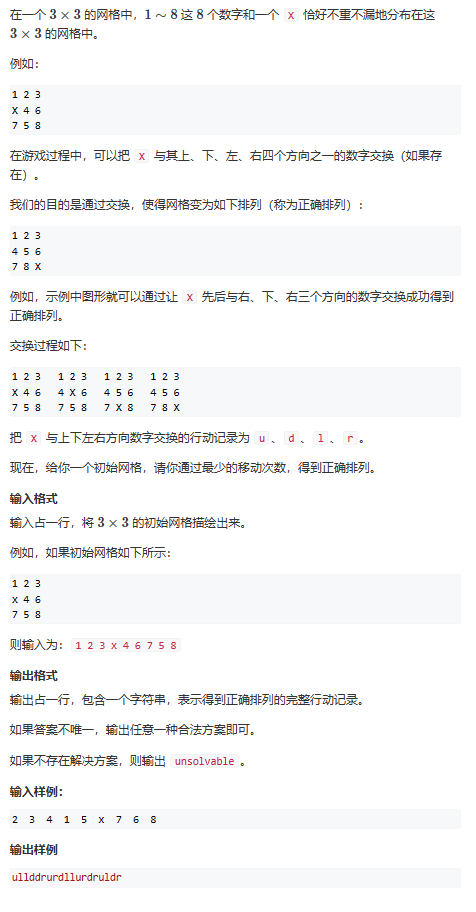BFS(三):A*
A*算法的思路和证明
A*算法的思路:
A*算法的目的是优化bfs的搜索空间,如下图所示,我们正常的搜索空间是灰色面积,但是我们的A*算法根据我们的决策,每次选择相对于更加好的决策,优化搜索空间,最后优化的搜索空间更接近与红色面积。

A*算法是针对于所有的非负权边,题目必须有解,不然A*算法的会搜索所有的空间,不如朴素的bfs,因为A*算法维护优先队列,比普通队列多了O(logn)的时间复杂度。
A*算法包含以下几点:
- 相对于
bfs维护的队列不同,A*使用一个优先队列维护从起点s到当前点u的真实距离d(u)和从前点u到终点t预估距离f(u)。 - 当终点第一次出队的时候
break。 dijkstra算法是一种特殊的A*算法,所有的到终点预估距离都是f(u) = 0。- 每个点
u到终点的预估距离f(u)必须小于等于真实距离g(u),这样可以保证最后终点出来是最优解。
A*的相关证明
为什么我们每个点u到终点的预估距离f(u)必须小于等于真实距离g(u),这样可以保证最后终点出来是最优解?
假设法:
假设我们终点出队的时候dist并不是最优解$$d_{最优解}$$也就是$$dist > d_{最优解}$$
此时我们的队列中肯定会有一个最优解中的某一个点u存在,并且有$$d(u) + f(u) \le d(u) + g(u) = d_{最优解}$$因此,我们的u满足$$d(u) + f(u) \le d_{最优解}$$因此我们队列头出来的结果dist满足$$d(u) + f(u) < dist$$这个和我们优先队列头dist是最小值矛盾。因此我们驳回原有假设。所以每个点u到终点的预估距离f(u)必须小于等于真实距离g(u),这样可以保证最后终点出来是最优解。
A*深入理解
我们首先假设除了点n1其余所有点的预估函数值f(x) = 0,并且点n1的预估函数等于他相对终点的真实距离L,这个假设满足我们的$$f(x) \le g(x)$$的条件。如下图所示,我们的点已经扩展到n1和n2,因为$$d(n1) + f(n1) < d(n2) + f(n2)$$所以我们会优先扩展n2这条线路。

当我们更新到点n4的时候,也就是n4出队的时候,我们存储的值是$$f(n4) + d(n4) = 4$$但是如果我们按照n1线路走的话,也就是按照最优线路走的话,我们得到的值应该是$$d(n4) + f(n4) = 3$$由此可以看出,出队的最小距离只针对终点成立,对其余点都不成立。
但是我们A*算法是如何拨乱反正的呢?当我们按照n2线路走到n3的时候,我们队列维护的值到了$$d(n3) + f(n3) = L$$这个时候我们会发现队列中最小的点是n1,于是我们就会走n1的道路再走到终点。此时我们会再次经过n4。由此可见我们每一个点出队列之后还是有可能会访问。

bfs,dijkstra,A*总结
- 对于
bfs,我们每一个点都只会入队一次,所以我们入队判重。 - 对于
dijkstra,我们一旦出队就是最优解,所以我们出队判重。 - 对于
A*,我们除了终点出队是最优解,其余点出队都不是最优解,每一个点出来都更新一次就好了。
相关题目
题目1
注意
- 我们每个访问到的点之前都可能访问过,如果起点到当前点的距离没有之前访问小,就不用访问了。
- 我们需要记录下来起点到当前点的距离,并且一直更新。
代码
1 | import java.io.*; |
题目2:
题目
思路
这个题目需要求第k短的路径长度,那么我们入队需要把所有的点都扩展,不能因为优化,只如小的点。当我们遍历到第k次终点时,那就是第k短路。同时我们估计当前点到终点的距离,就看做是当前点到终点的最短距离,由dijkstra计算。记住这个时候我们有两个h数组,一个是正向的用作astar一个是逆向的用作dijkstra。
为什么第k个终点就是第k短路?
- 假设我们第2个出来的终点不是第k短路,由于最短路之前已经出来过了,所以我们队列里面含有一个点u。能满足$$f(u)+d(u) < dk < d(u) + f(u)$$ 这样和我们队列头是最小的矛盾,所以第k个出来的就是第k短路。这个结论对所有的终点有效
代码1
2
3
4
5
6
7
8
9
10
11
12
13
14
15
16
17
18
19
20
21
22
23
24
25
26
27
28
29
30
31
32
33
34
35
36
37
38
39
40
41
42
43
44
45
46
47
48
49
50
51
52
53
54
55
56
57
58
59
60
61
62
63
64
65
66
67
68
69
70
71
72
73
74
75
76
77
78
79
80
81
82
83
84
85
86
87
88
89
90
91
92
93
94
95
96
97
98
99
100
101
102
103
104
105import java.io.*;
import java.util.*;
class Main{
public static int N= 1010,M = 20010,idx,k;
public static int[] h = new int[N],rh = new int[N],e = new int[M],ne = new int[M],w = new int[M],f = new int[N],d = new int[N];
public static boolean[] stu = new boolean[N];
public static BufferedReader br = new BufferedReader(new InputStreamReader(System.in));
public static void add(int[] h,int a,int b,int x){
e[idx] = b;
w[idx] = x;
ne[idx] = h[a];
h[a] = idx++;
}
public static void dijkstra(int start){
PriorityQueue<Pair> queue = new PriorityQueue<>(new Comparator<Pair>(){
public int compare(Pair o1,Pair o2){
return o1.d - o2.d;
}
});
queue.add(new Pair(start,0,0));
f[start] = 0;
while(!queue.isEmpty()){
Pair u = queue.remove();
int x = u.x,d1 = u.d;
stu[x] = true;
for(int i = rh[x];i != -1;i = ne[i]){
int tx = e[i],td = w[i];
if(!stu[tx] && f[tx] > d1 + td){
f[tx] = d1 + td;
queue.add(new Pair(tx,f[tx],0));
}
}
}
}
public static int astar(int start,int end){
int cnt = 0;
PriorityQueue<Pair> queue = new PriorityQueue<>(new Comparator<Pair>(){
public int compare(Pair o1,Pair o2){
return o1.d - o2.d;
}
});
queue.add(new Pair(start,f[start],0));
while(!queue.isEmpty()){
Pair u = queue.remove();
int x = u.x,d = u.d,tr = u.tr;
if(x == end){
cnt++;
}
if(cnt == k){
//
return d;
}
for(int i = h[x];i != -1;i = ne[i]){
int tx = e[i],tw = w[i];
if(f[tx] == 0x3f3f3f3f) continue;
queue.add(new Pair(tx,f[tx]+tw+tr,tw+tr));
}
}
return -1;
}
public static void main(String[] args)throws Exception{
String[] s1 = br.readLine().split(" ");
int n = Integer.parseInt(s1[0]),m = Integer.parseInt(s1[1]);
Arrays.fill(h,-1);
Arrays.fill(rh,-1);
Arrays.fill(f,0x3f3f3f3f);
Arrays.fill(d,0x3f3f3f3f);
for(int i = 1;i <= m;i++){
String[] s2 = br.readLine().split(" ");
int a = Integer.parseInt(s2[0]),b = Integer.parseInt(s2[1]),x = Integer.parseInt(s2[2]);
add(h,a,b,x);
add(rh,b,a,x);
}
String[] s3 = br.readLine().split(" ");
int start = Integer.parseInt(s3[0]),end = Integer.parseInt(s3[1]);
k = Integer.parseInt(s3[2]);
dijkstra(end);
if(start == end){
k++;
}
System.out.print(astar(start,end));
}
static class Pair{
int x;
int d;
int tr;
public Pair(int x,int d,int tr){
this.x = x;
this.d = d;
this.tr = tr;
}
}
}
